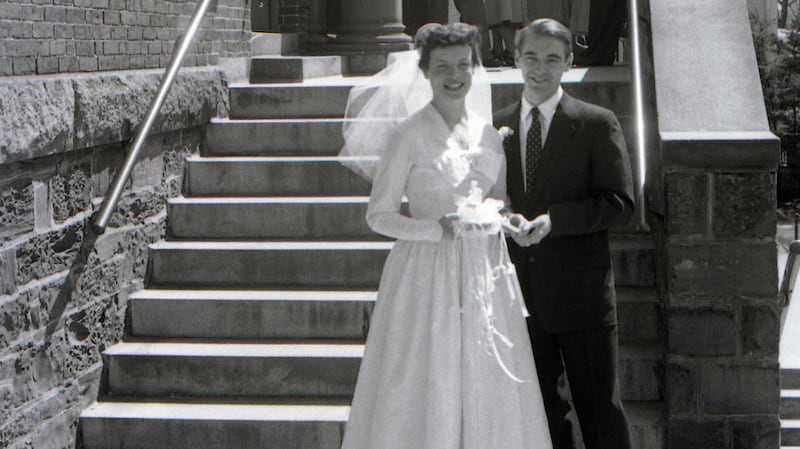“Out of the darkness this elegant, splendidly dressed young woman appeared. She sprang up on the stage, wielding a large and dangerous looking pair of outsize shears. Grabbing the flimsy hem of my rough hessian tunic she proclaimed, ‘That’s far too long!’ and sliced off about a foot of material. I decided this was a lady to be kept at arm’s length.” – Brian Farrell describing his first encounter with Marie-Thérèse Dillon at a rehearsal of Deirdre of the Sorrows in UCD’s DramSoc in 1951.
My parents’ first meeting is family legend; it’s just one of the many stories recounted over the years, but of course they change with the telling, especially if my mother is storyteller. “Don’t let the facts” and a little chuckle invariably accompany any story associated with Marie-Thérèse, but as one old family friend once said, “To hell with the facts, I love your mother’s stories!” As do we all. My father especially loved them.
Fast forward a few decades. I was sitting on the floor of my sister Naomi’s living room as we sorted through boxes of documents and photos saved by my father from my mother’s notorious blitzes. Being half-Swiss, Marie-Thérèse hated clutter and dumped without an ounce of regret.
“He was such a hoarder,” Naomi raised her eyes as we tackled the grey metal cabinet that came from Brian’s office in UCD and that’s where we found my parents’ correspondence.
Their letters cover the period of time when my father was studying for his Masters at Harvard while my mother remained in Ireland, anxiously awaiting the date when she could join him in America for a spring wedding. It was impossible to ignore such a treasure trove, emerging from the past into my hands. Here were my parents, two bright young lovers, the last of the great letter-writing generation, providing a snapshot of a past time, so different from today.

I began to sort through the letters, not a simple task as dates were few and far between. Once I’d sorted them chronologically, I began to select letters in order to pull in enough threads to tell a story, and then I realised that I had to publish them. The title, PS Look out for Snakes, came from one letter, in which Marie Thérèse warned her beloved to beware of the dangers of the new world.
Their correspondence starts out on a balmy Sunday evening, in mid-July 1954, when Marie-Thérèse and Brian took the bus from town to Killiney for one last walk together before Brian set off on his travels. Marie-Thérèse wrote in one of her letters, “I was sitting beside you on the bus pretending to be interested in who was going into and leaving the toilets at College Street, and crying quietly to myself, wondering how I would endure the months to follow.”
But she didn’t let her feelings spoil her last weekend with Brian. They walked up Killiney Hill and settled down on a grassy spot; Brian cracked jokes and Marie-Thérèse hid her sadness. She wanted him to remember her happy, smiling face in the months to come. “No one likes the company of a sad person,” she was known to remark in later years. So they chatted and made plans for their future; then, linking arms, they walked to Killiney station and took the train back to Booterstown for supper followed by coffee cake, one of Brian’s favourites.
The following day, Brian set off for America. He had won the prestigious Fulbright Scholarship, an opportunity that he couldn’t turn down, even though it meant leaving his fiancee for nearly eight months. Marie-Thérèse supported his decision to go, since a wedding didn’t seem likely until Brian had established some sort of career, and in the atmosphere of doom and gloom that prevailed in Ireland at the time, there wasn’t much hope of that happening any time soon. So, with her blessing, off he went.

The letters not only provide a personal insight into a unique Irish couple at the beginning of their life together but are also a real-time commentary on social and political life in both Ireland and the United States in the mid-1950s. Brian is greatly taken with Harvard and writes of the political contrasts of an idealistic postwar America also at the height of the McCarthy era. Marie-Thérèse’s letters discuss an Ireland slowly becoming a modern state and where their future may or may not lie. In between, they reflect on the personal challenges of their young lives, and swap vital news of friends and family.
And then there is their enduring love story. In Brian’s last letter to Marie-Thérèse, he writes: “Now, for a moment, to get back to you, YOUNG WOMAN. Behave yourself on board ship: I don’t mean you mustn’t flirt, but you mustn’t run away. Do take good care of yourself, my own, and remember me to everyone in Dublin. Remember too, that I’m waiting for you. With all my love and a special kiss because you look so lovely today (I know you do), Brian.”
PS Look out for Snakes: The Love Letters of Brian Farrell and Marie-Thérèse Dillon (1954 -55) edited by Miriam Farrell Shtaierman, is published by Katounia Press










